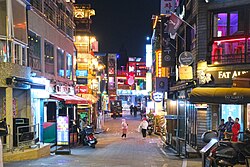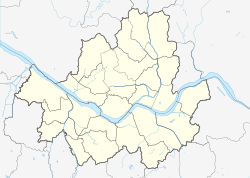Itaewon
Itaewon | |
|---|---|
| Korean transcription(s) | |
| • Hangul | 이태원 |
| • Hanja | 梨泰院 |
| • Revised Romanization | Itaewon |
| • McCune–Reischauer | It'aewŏn |
 Itaewon food street, December 2022 | |
| Coordinates: 37°32′N 126°59′E / 37.533°N 126.983°E | |
| Country | South Korea |
| City | Seoul |
| District | Yongsan District |
| Neighborhood | Itaewon-dong |
Itaewon (Korean: 이태원; Korean pronunciation: [itʰɛwʌn]) is a multi-cultural commercial area[1][2][3][4][5] located in Seoul, South Korea. It is one of the most popular neighborhoods in Seoul, known for its nightlife and trendy restaurants.[6][7][8]
Etymology
[edit]The name Itaewon was originally derived from the name of an inn located there during the Joseon period. Today it's called Itaewon alluding to its abundance of pear trees (梨泰院).[9] According to a folktale, the name was also written using different Hanja characters that alluded to foreign babies (異胎院). When the Japanese invaded Seoul (1592–1593) during the Imjin War, a group of Japanese soldiers seized a Buddhist temple in what is now Itaewon where Buddhist nuns lived. The soldiers stayed at the temple for a while and raped the Buddhist nuns. When the soldiers left they burned down the Buddhist temple. The raped Buddhist nuns now homeless settled nearby and eventually gave birth to children. People from neighboring villages named the area where the children were raised Itaewon in a portmanteau of terms meaning different, foreign and fetus.[10] During the Imjin War this was also where wounded and surrendered Japanese soldiers (이타인/異他人) were allowed to live.[11]
History
[edit]
Itaewon was originally a transportation hub where travelers could get horses during the Goryeo period (918-1392). During the Joseon period (1392–1910), Itaewon became more of a significant area as the new leaders relocated the country's capital to Hanyang – modern-day Seoul. As foreigners began to enter Korea in the 1880s, embassies and inns began to pop up in the region. Apart from Incheon, Itaewon became one of the most prominent spots for foreigners and travelers heading in and out of the capital city. Itaewon housed the city's largest cemetery until 1937.[12]
The recent history of the Itaewons district of Seoul's Yongsan District is closely linked to the US military base Yongsan Garrison established in 1945. With the large number of bars and brothels, the area has been coded as a dangerous place for many Koreans. Here, security was not just a local matter but sometimes blew up into national or geopolitical crises. Since U.S. soldiers were given pleasure leave from 1957, brothels sprung up in Itaewon. Minors and women were kidnapped and forced into prostitution well into the 1980s in camp villages that operated under U.S. jurisdiction, and the South Korean government designated some of the locations given over to U.S. authorities as official "comfort facilities" for soldiers.[citation needed] Under this system, there was an absence of full legal accountability in the face of frequent abuses committed by American GIs. Criminal liability was limited in many cases where GIs would attack or abuse women living in the camp villages. The Status of Forces Agreement between the U.S. and South Korean government stipulated that all crimes committed by U.S. military personnel fell exclusively under the jurisdiction of U.S military courts. A National Assembly report from that time compiled a list of 39,542 crimes committed by U.S. military personnel between 1967 and 1987, including murders, rapes, theft, arson, and smuggling, which went largely unpunished.
Twenty years after the Korean War (1950–53), Itaewon became a shopping district. The district gradually became gentrified and, in 2013, the US military moved its base with 17,000 soldiers to southern Seoul. Itaewon also became something of a home for the LGBT movement and was considered to be as open to foreigners as it was to Koreans. However, while representative commercial buildings had been erected in Itaewon, the area's characteristic of narrow streets had remained.[13][14][15]
Local attractions
[edit]


As Seoul's International District, Itaewon is known for serving cuisine that are not widely available in Korea, such as those from Great Britain, Germany, France, India, Italy, Southeast Asia, Portugal, Spain, Turkey, Mexico, United States of America and Canada. Essentially, it is known as the "International District" or sometimes as "Western Town," reminiscent of many Chinatowns in Western nations.[citation needed] All That Jazz, the oldest active jazz club in South Korea, is located in Itaewon.[16][17] Itaewon Books, the oldest English-language used secondhand bookstore, is also here.[18]
Itaewon, along with neighborhoods and attractions like Hongdae, Insadong and Seoul Tower, is one of the most popular places in Seoul for tourists.[19]
Itaewon includes the area known as Homo Hill and is Seoul's gay village.[20] Despite the taboo nature of homosexuality in South Korea, people can express themselves openly within the neighborhood.[21]
Itaewon is also a district with a strong Muslim community, it is home to the Seoul Central Mosque, built in 1976.

Itaewon was long known as a hub for high quality counterfeit goods, but those products have largely disappeared.[22] Some authentic goods that are only produced in Korea for the international market, as well as some authentic imports are also available. Itaewon is known for its clothes makers who produce custom-made shirts and suits.[citation needed]
There is the multinational Gyeongnidan Street in Itaewon. It is in the middle of Itaewon Elementary School(Korean: 이태원초등학교) district. There are many international restaurants along the street.[23]
Incidents
[edit]
COVID-19 outbreak
[edit]During the COVID-19 pandemic Itaewon was a source of a major disease cluster traced back from over 130 confirmed cases. South Korea's media began focusing on the neighborhood after public health authorities announced that a man who later tested positive for the coronavirus visited several establishments in the area on 2 May. Because of the outbreak in Itaweon, homosexuals have been stigmatized.[24]
2022 crowd crush
[edit]On 29 October 2022, a crowd crush occurred during the 2022 Halloween festival. Over 150 people were confirmed dead and over 100 were injured.[25][26] Of the confirmed dead, 26 were foreign nationals. The influx of visitors from all over the country as well as foreign nationals was potentially caused by the pandemic restrictions being lifted after two years. It is said that the hotels and events were booked well before the event showing that large crowds were expected.[27]
In popular culture
[edit]Korean singer-songwriter JYP (Park Jin-young) and Yoo Se-yoon's hip hop duo UV released the song "Itaewon Freedom" in April 2011.[28] The title alludes to (and the lyrics celebrate) a common Korean perception of Itaewon's "open atmosphere", in contrast with conventional Korean culture, which is more conservative.[29] The popularity of the song and its music video inspired a parody cover song and video from the girl group Crayon Pop in 2013. Both videos were partially filmed on location in Itaewon.[30]
The 2020 South Korean Netflix television series Itaewon Class is set in Itaewon.[31] The drama was praised for its diverse and inclusive cast and its realistic portrayal of subjects such as prejudice and discrimination against foreigners, ex-convicts and the LGBT people, as well as the portrayal of misbehaviors by chaebol corporations.[32] Time Magazine included Itaewon Class on its list of "The 10 Best Korean Dramas to Watch on Netflix" and Forbes included the series on its list of "The 13 Best Korean Dramas Of 2020".[33] Visitors to Itaewon can visit the original DanBam pub now called SeoulBam, which features famous dishes from the show such as soft tofu stew and spicy stir-fried pork.[34]
Transportation
[edit]It is served by Seoul Subway Line 6 via Itaewon, Noksapyeong and Hangangjin stations.
See also
[edit]Notes
[edit]- ^ Sang-Hun, Choe (29 October 2022). At Least 151 Killed as Halloween Crowd Surge Turns Deadly in South Korea.
{{cite book}}:|work=ignored (help) - ^ Itaewon.
- ^ Top drinks, food & shopping in Itaewon, the multicultural district.
- ^ Here's Why Itaewon Is a Model Neighborhood for Diversity. 19 February 2018.
- ^ Itaewon: An inclusive, multicultural hub hit with tragedy.
- ^ Lai, Ah Eng; Collins, Francis Leo; Yeoh, Brenda S. A. (2013). Migration and Diversity in Asian Contexts. Institute of Southeast Asian Studies. ISBN 9789814380478.
- ^ What we know about the deadly Halloween disaster in Seoul. 30 October 2022.
{{cite book}}:|website=ignored (help) - ^ Sang-Hun, Choe (29 October 2022). At Least 151 Killed as Halloween Crowd Surge Turns Deadly in South Korea.
{{cite book}}:|work=ignored (help) - ^ "이태원(梨泰院", Encyclopedia of Korean Culture.
- ^ Tudor, D. (2012). Korea: The Impossible Country: South Korea's Amazing Rise from the Ashes: The Inside Story of an Economic, Political and Cultural Phenomenon. Tuttle Publishing. p. 310. ISBN 978-1-4629-1022-9.
- ^ Jun-gi, Kim. "Itaewon". Encyclopedia of Korean Folk Culture. Retrieved 3 January 2022.
- ^ "Itaewon's Complex History and What's to Come". Pinpoint Korea. 2022-08-11. Retrieved 2023-01-07.
- ^ Se-Woong Koo (2022-11-04). "Seoul's Nightlife District Was Built for Tragedy". curbed.com. Retrieved 2022-12-26.
- ^ Eunwoo Lee (2022-11-08). "Itaewon, the Site of Seoul's Recent Catastrophe - The city's multicultural history illuminates South Korea's agony, modernity, and future". inkstickmedia.com. Retrieved 2023-01-07.
- ^ "Tim Shorrock". The New Republic. Retrieved 2023-04-19.
- ^ "All That Jazz". Time Out. 2017-08-16. Retrieved 2024-08-16.
- ^ 윤, 수정 (2022-08-30). 한국 재즈의 성지 '올 댓 재즈' 올가을 관객들과 다시 만난다. The Chosun Ilbo (in Korean). Retrieved 2024-08-17.
- ^ "From used cookbooks to Virginia Woolf, Seoul's independent English bookstores have you covered". Korea JoongAng Daily. 2024-02-10. Retrieved 2024-10-20.
- ^ Government, Seoul Metropolitan (2010-02-02). "Seoul's best 100".
- ^ "Itaewon". The Seoul Guide. Retrieved 11 May 2020.
- ^ "Gay Seoul". Gay Travel. Retrieved 11 May 2020.
- ^ Kim, Monica (27 August 2018). "Listen to Monica Kim Discuss How Korea's Counterfeit Culture Shaped Her Style". Vogue. Retrieved 2019-03-12.
- ^ Government, Seoul Metropolitan (2014-09-18). "Soul food of Seoul: Seoul Dining, A Delicious Epicurean Journey".
- ^ "How South Korea's Nightclub Outbreak Is Shining an Unwelcome Spotlight on the LGBTQ Community". Time. Retrieved 2022-11-06.
- ^ Lee Jung-Youn; Shin Ji-hye (2022-10-30). "153 dead, 103 injured amid Itaewon Halloween crowd surge: officials". The Korea Herald. Retrieved 2022-10-29.
{{cite web}}: CS1 maint: multiple names: authors list (link) - ^ Park Eun-Jee (2022-10-30). "Crush in Korea's Itaewon claims almost 150 lives". Korea JoongAng Daily. Retrieved 2022-10-29.
- ^ Jeong, Sophie; Bae, Gawon; Hancocks, Paula; Whiteman, Hilary; Yeung, Jessie (October 30, 2022). "What we know about the deadly Halloween disaster in Seoul". CNN. Retrieved October 30, 2022.
- ^ "[New Releases] UV". Korea JoongAng Daily. 26 September 2011.
- ^ Kim, Chan-hee (2011). "The Cultural Identity of Itaewon" (PDF). Yonsei University. Archived from the original (PDF) on 15 November 2016. Retrieved 3 October 2018.
- ^ "Crayon Pop takes to the streets for parody MV of 'Itaewon Freedom'".
- ^ Choi, Ji-won (January 30, 2020). "Park Seo-joon to show perfect sync with original webcomic in 'Itaewon Class'". The Korea Herald. Retrieved February 7, 2020.
- ^ Auto, Hermes (2020-03-28). "Social taboos unveiled in hit South Korean drama Itaewon Class | The Straits Times". www.straitstimes.com. Retrieved 2022-11-02.
- ^ MacDonald, Joan. "The 13 Best Korean Dramas Of 2020". Forbes. Retrieved 2022-11-02.
- ^ Hatfield, Ian (2024-05-22). "Seoul Nightlife Guide: Itaewon, Hongdae, Gangnam, Euljiro & More | Wander Seoul". www.wanderseoul.com. Retrieved 2024-05-24.
External links
[edit]- Official Seoul City Tourism :Itaewon Archived 2019-07-10 at the Wayback Machine

